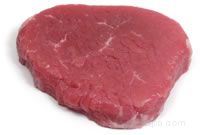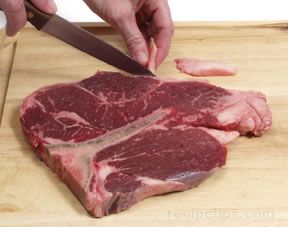Comparison of Various Cuts of Beef with Chicken | Miscellaneous Nutritional Tips
|
 The USDA recommends 2 or 3 servings of meat, fish, or poultry per day. One serving of cooked beef is equal to 3 ounces and is about the size of a deck of cards. Beef is high in protein and contains thiamin, niacin, zinc, vitamin B-12, and iron. About 2.5 milligrams of iron is contained within one 3 ounce serving of beef. This is approximately 14 % of the recommended daily allowance. The type of iron in beef is known as heme iron, which the body is able to absorb more easily than the variety of iron found in plants. The USDA recommends 2 or 3 servings of meat, fish, or poultry per day. One serving of cooked beef is equal to 3 ounces and is about the size of a deck of cards. Beef is high in protein and contains thiamin, niacin, zinc, vitamin B-12, and iron. About 2.5 milligrams of iron is contained within one 3 ounce serving of beef. This is approximately 14 % of the recommended daily allowance. The type of iron in beef is known as heme iron, which the body is able to absorb more easily than the variety of iron found in plants.
Concerns over saturated fat and cholesterol have caused many people to reduce or eliminate their consumption of beef and other meats, but beef can be part of a healthy, low fat, low cholesterol diet. When lean cuts are selected and low fat cooking methods are used, beef can be a very healthy part of the diet. The leanest cuts of beef have the words "loin" or "round" contained within the description such as tenderloin, eye of round, or top round. Low fat cooking methods include broiling, baking, roasting, grilling, steaming, stewing, and braising. |
|
About half the fat in beef is monounsaturated which is the same healthy type of fat found in olive oil. The monounsaturated fatty acids found in beef can help decrease the LDL (bad) cholesterol in the blood and help to increase the HDL (good) cholesterol. The leanest cuts of beef have an average of 70 to 80 mg. of cholesterol. Some cuts have even less than this. The top loin, for example, has 65 mg. of cholesterol and the eye round has only 60 mg. This compares very well to a skinless chicken breast which has 70 mg. of cholesterol per 3 ounce serving. It is recommended that no more than 300 mg. of cholesterol per day should be consumed, so 2 or 3 servings of lean beef per day allows plenty of room before reaching the maximum recommended level.
 As with any type of meat, trimming excess fat from beef is essential in reducing saturated fat and cholesterol from the diet. However, doing this before the meat is cooked can make the meat tougher and less flavorful, especially if it is broiled, roasted, or grilled. Trimming the remaining fat after cooking will eliminate some of the saturated fat and cholesterol, but some of it will have melted into the meat during the cooking process, acting as a natural tenderizer. In some cases, you may have to decide if the elimination of as much of the fat as possible before cooking is more important than enjoying the optimum flavor and tenderness that results from the inclusion of the fat. The bottom line is that moderation is the key when enjoying any type of food and that it is important to include all of the essential food groups in a well balanced diet. As with any type of meat, trimming excess fat from beef is essential in reducing saturated fat and cholesterol from the diet. However, doing this before the meat is cooked can make the meat tougher and less flavorful, especially if it is broiled, roasted, or grilled. Trimming the remaining fat after cooking will eliminate some of the saturated fat and cholesterol, but some of it will have melted into the meat during the cooking process, acting as a natural tenderizer. In some cases, you may have to decide if the elimination of as much of the fat as possible before cooking is more important than enjoying the optimum flavor and tenderness that results from the inclusion of the fat. The bottom line is that moderation is the key when enjoying any type of food and that it is important to include all of the essential food groups in a well balanced diet.
|
Comparison of Various Cuts of Beef with Chicken
All values in the table below are based on a comparison between a 3
ounce portion of skinless chicken breast and a 3 ounce portion of beef (about
the size of a deck of cards) that has been cooked with the excess fat removed.
Chicken
Breast
|
Various
|
120
|
1.5
|
0.5
|
70
|
24 |
| Cut of Beef |
Cooking
Method |
Calories |
Total
Fat
(grams) |
Saturated
Fat
(grams) |
Cholesterol
(milligrams) |
Protein
(grams) |
Eye
Round |
Roasted |
140 |
4.2 |
1.5 |
60 |
25 |
Top
Round |
Broiled |
150 |
4.2 |
1.4 |
70 |
27 |
Round
Tip |
Roasted |
160 |
5.9 |
2.1 |
70 |
24 |
Top
Sirloin |
Broiled |
170 |
6.1 |
2.4 |
75 |
26 |
Bottom
Round |
Braised |
180 |
6.3 |
2.1 |
80 |
27 |
Top
Loin |
Broiled |
180 |
8.0 |
3.1 |
65 |
24 |
Beef
Tenderloin |
Broiled |
180 |
8.5 |
3.2 |
70 |
24 |
Rib
Steak |
Broiled |
190 |
10.0 |
4.0 |
70 |
24 |
Chuck
Blade Roast |
Braised |
210 |
11.0 |
4.0 |
90 |
26 |
Ground Beef
90% Lean |
Various |
210 |
11.0 |
4.0 |
85 |
27 |
Miscellaneous Nutritional Tips
- Careful inspection of beef in the United States makes it safe to eat. Because of strict codes, there is little concern that beef provided to the consumer will be infected with animal diseases which may be harmful to humans.
- When shopping for beef, look for "loin" and "round" in the names of the cuts because these tend to be the leanest.
- Marbling refers to the bits of fat that are scattered throughout a cut of beef. The marbling helps to make the meat tender and flavorful, but it will not significantly increase the level of fat that is consumed, especially if the beef is cooked using low fat cooking methods and if the outer layers of fat are removed before cooking. (It is important to note that removing the outer layers of fat may make the meat a bit tougher after it is cooked).
- Remove the excess fat to make the cut of beef as lean as possible. Although this may be desirable for people who want less fat in their diet, this will also make the beef a bit tougher after it is cooked. The fat can be removed after cooking, but some of it will melt and be absorbed into the meat during cooking.
- Low fat cooking methods including broiling, grilling, steaming, stewing, braising, baking, and roasting, should be used for preparing beef.
- When cooking beef in the oven, it is beneficial to place a rack in the pan or baking dish and place the beef on the rack so that fat can drain away from the beef as it cooks.
- Fat can be skimmed from the surface of beef soups, stews, and sauces before serving. Soups and stews can also be chilled to make the removal of fat easier because the fat will rise to the surface and congeal, allowing it to be removed in solid pieces.
- Place cooked hamburger patties on paper towels and pat them with more paper towels to absorb as much of the excess grease as possible before serving.
| |

 The USDA recommends 2 or 3 servings of meat, fish, or poultry per day. One serving of cooked beef is equal to 3 ounces and is about the size of a deck of cards. Beef is high in protein and contains thiamin, niacin, zinc, vitamin B-12, and iron. About 2.5 milligrams of iron is contained within one 3 ounce serving of beef. This is approximately 14 % of the recommended daily allowance. The type of iron in beef is known as heme iron, which the body is able to absorb more easily than the variety of iron found in plants.
The USDA recommends 2 or 3 servings of meat, fish, or poultry per day. One serving of cooked beef is equal to 3 ounces and is about the size of a deck of cards. Beef is high in protein and contains thiamin, niacin, zinc, vitamin B-12, and iron. About 2.5 milligrams of iron is contained within one 3 ounce serving of beef. This is approximately 14 % of the recommended daily allowance. The type of iron in beef is known as heme iron, which the body is able to absorb more easily than the variety of iron found in plants. As with any type of meat, trimming excess fat from beef is essential in reducing saturated fat and cholesterol from the diet. However, doing this before the meat is cooked can make the meat tougher and less flavorful, especially if it is broiled, roasted, or grilled. Trimming the remaining fat after cooking will eliminate some of the saturated fat and cholesterol, but some of it will have melted into the meat during the cooking process, acting as a natural tenderizer. In some cases, you may have to decide if the elimination of as much of the fat as possible before cooking is more important than enjoying the optimum flavor and tenderness that results from the inclusion of the fat. The bottom line is that moderation is the key when enjoying any type of food and that it is important to include all of the essential food groups in a well balanced diet.
As with any type of meat, trimming excess fat from beef is essential in reducing saturated fat and cholesterol from the diet. However, doing this before the meat is cooked can make the meat tougher and less flavorful, especially if it is broiled, roasted, or grilled. Trimming the remaining fat after cooking will eliminate some of the saturated fat and cholesterol, but some of it will have melted into the meat during the cooking process, acting as a natural tenderizer. In some cases, you may have to decide if the elimination of as much of the fat as possible before cooking is more important than enjoying the optimum flavor and tenderness that results from the inclusion of the fat. The bottom line is that moderation is the key when enjoying any type of food and that it is important to include all of the essential food groups in a well balanced diet.